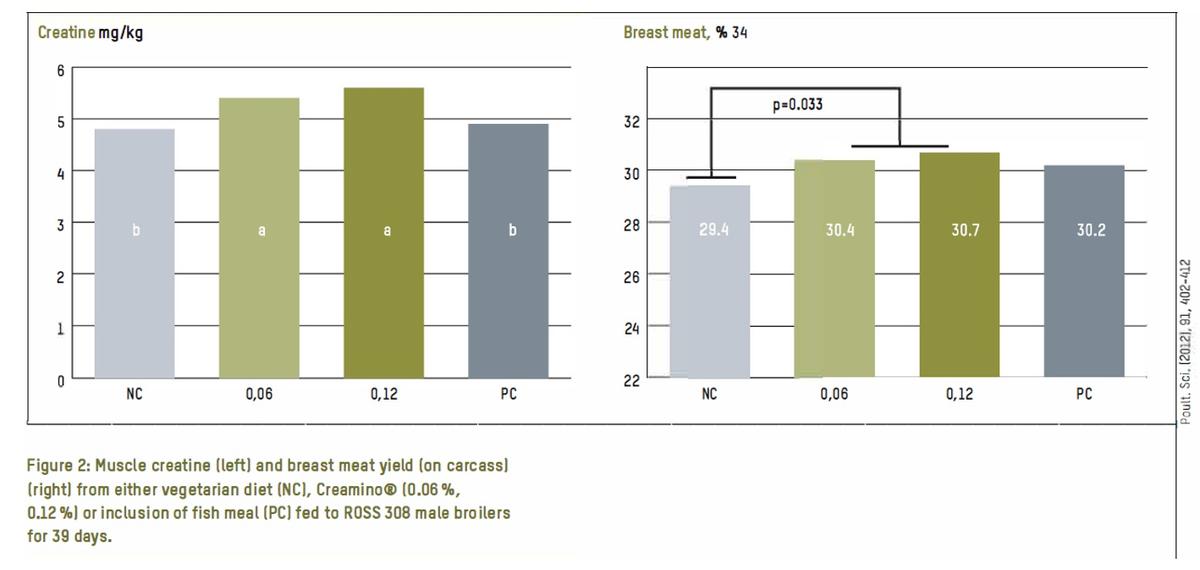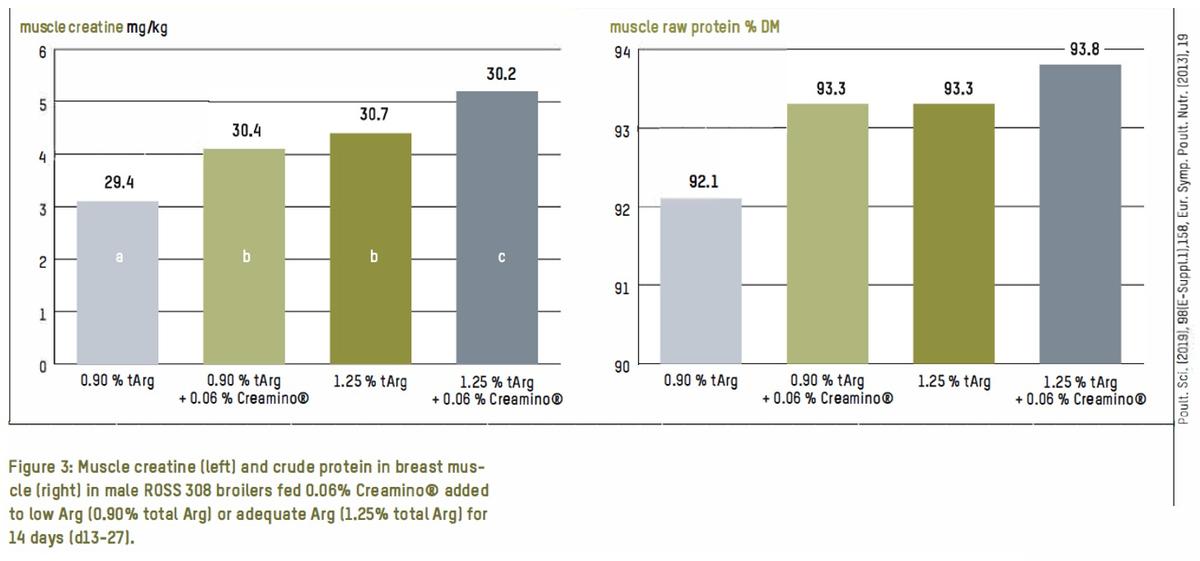Adequate muscle creatine Why is it important for broilers?
Published: April 16, 2021
By: Dr. Ulrike Braun, AlzChem.
Published in: Feedmagazine / Kraftfutter
Birds are omnivorous species, they are evolutionarily designed to consume products from plant and animal origin. However, for several reasons, poultry nutrition is shifting more and more to a vegetable diet. This shift has resulted in losing some important benefits of animal products, including creatine, an essential com-pound found in meat but not in plants.
A feed ingredient survey conducted at AlzChem showed that creatine values found for meat meal (n=38) or fish meal (n=25) are low (median at 0.2 and 1.1 g/kg respectively) and drastically below the values expected from fresh origins when calculated on dry matter (16.7 g/kg from fish, 217 g/kg from meat). So, creatine is lost on the way from the original natural substance to the feed ingredient (Table 1).
Why is creatine important?
Creatine is an essential molecule for cellular energy supply. Its active form phosphocreatine is the immediate backup reservoir in the body to replenish ATP, the central energy source in the cell.
As without ATP any cell will die, the body stores creatine for times when ATP need is higher than production via mitochondria or metabolism of carbohydrates or lipids. If creatine is not provided from food, body creatine levels are compromised and must be supplied entirely by de novo endogenous synthesis from amino acids.
The body can run short in ATP on many occasions.
To name a few:
- Rapid growth, where important amounts of ATP are absorbed for protein synthesis
- Excitement or stress, not only for escape but also for marcophages to fight pathogens
- Low oxygen supply leading to low ATP production
- Disturbed energy metabolism, i.e. impaired mitochondrial function.
All of these conditions are also found in poultry husbandry and might have increased over the past years. Broiler growth has improved dramatically since the last 50+ years (roughly a factor of four since 1957). Growth was directed specifically to increased carcass (+ 12 % ) and breast meat yield (+50 %).
White muscle (such as chicken breast) consists almost solely of muscle fibers high in creatine (fast twitch type IIb fibers).
Knowing that creatine not only supports myogenesis but also stabilizes cell membranes, can we speculate that the substantial carcass and breast muscle growth was supported by elevating muscle creatine?
In fact, in 1956, just -3gr creatine per kg muscle are reported in 21d broilers fed practical diets, but -4 gr/kg muscle are found in 2018 for broilers of the same age (+33%). lt seems evident that more creatine is stored in the muscle to support growth. Are these levels adequate?
Options to provide creatine to broilers
Dietary supplementation with creatine has proven to increase muscle creatine by roughly 20 % in humans. Effects are most pronounced when natural creatine from food is low. Creamino®, a preparation containing the creatine precursor guanidinoacetic acid (GAA, 96 % min), is established as a highly efficient source of creatine for broilers.
A dose range of 600 to 1200 mg/kg feed was derived from growth experiments whilst - 600 mg/kg are suggested from a factorial calculation. Interestingly, 1086 mg creatine/kg feed would be obtained from 5 % inclusion of fish meal containing creatine as present in dry fish (21.7 g/kg), so falling in the same range as derived for Creamino® (Figure 1).
Comparison to fish meal
Creamino® has been shown in numerous experiments to elevate muscle creatine in broilers. In a comparison study (d 0-39) with ROSS 308 broilers, fishmeal (PC) added at 6 %, 3 % and 3 % in starter, grower and finisher diet respectively showed very low impact on muscle creatine ( +3 %) as compared to the pure plant based control (NC, corn/soy). This was expected from the poor creatine content in the fishmeal (1.7 g/kg).
In contrast, Creamino® added at 0.06 % or 0.12 % improved muscle creatine content ( + 11 % and + 16 % respectively ), (Figure 2, left). Performance effects were most striking in the grower phase (p<0.05) and overall (p<0.1), where 0.12 % GAA improved FCR by 4 points, whilst PC and NC were not different.
Contrast analysis showed that Creamino® groups improved final body weight compared to the pure plant based diet as did the fish meal diet. Creamino® groups had higher breast meat yield but similar leg yield, whilst fish meal had no effect on breast meat yield and even reduced lower leg yield.
Carcass yield and breast meat yield were clearly highest from the 0.12 % Creamino® treatment (+0.6 % and +0.5 % compared to NC and PC for carcass yield, + 1.3 % and +0.5 % compared to NC and PC for breast meat yield), altogether proving the relevance of muscle creatine for growth and protein formation (Figure 2, right).
Improved muscle creatine counteracts Arginine imbalance
Physiological creatine levels in the body modulate the endogenous syntheses of GAA from arginine and glycine via the AGAT enzyme. When serum creatine levels are high because of saturated muscle creatine, AGAT is downregulated and arginine and glycine are released for other purposes. In diets low in arginine, this effect is highly relevant.
This is evidenced by a feeding experiment for only two weeks (d13-27) with broilers fed an Arg-deficient basal diet or the basal diet with stepwise additions of L-Arg up to the requirement and with or without Creamino®. Supplementing Creamino® increased muscle creatine and bird performance at all levels of dietary Arg.
Looking at the extremes (0.90 % and 1.25 % total Arg), Creamino® showed highest response in muscle creatine at the lowest Arg-level ( +32 % at lowest Arg and + 18 % at adequate Arg). 0.06 % Creamino® or 0.35 % L-Arg added to the 0.90 % Arg diet achieved the same muscle creatine level (Figure 3, left).
Interestingly, independent of arginine, a trend towards elevation of breast muscle protein was observed (p=0.1 for Creamino and L-Arg), in line with the well established effect for creatine in human application (Figure 3, right).
Conclusion
There is clearly a deficiency of creatine in today's broilers. Even when fed diets containing animal proteins, muscle creatine stores are not adequately filled. Creamino® is an effective source of creatine as confirmed by improved muscle creatine and protein accretion.
Related topics:
Authors:
Alzchem Group AG
Influencers who recommended :
Mustafa Ayazi, Mohammed Mouhafid and 2 moreRecommend
Comment
Share
7 de diciembre de 2022
Hello! seeing the importance of Creatine for maximizing growth rate of broilers, do breeder companies now have a recommended level of creatine in the diet.
Recommend
Reply

Would you like to discuss another topic? Create a new post to engage with experts in the community.












